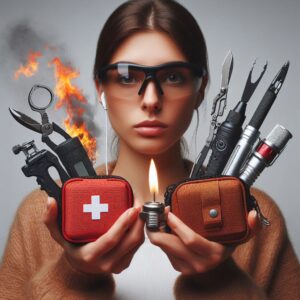If you’re gearing up for some outdoor fun—whether it’s hiking through the woods, camping under the stars, or just trying to survive a weekend without Wi-Fi—you need the right gear. The kind of stuff that makes hiking, camping, and surviving in the wilderness not just possible, but downright fun.
Think of it like this: you wouldn’t play a video game without a controller or a show up at a sword fight with a butter knife, right? Well, you wouldn’t want to head into the great outdoors without the right gear. Think of it like going into battle against Mother Nature. The difference between a great adventure and a miserable experience is all in the gear you bring along.
Hiking Gear: What You Need to Walk the Walk (and Not Get Blisters)
 First things first: your feet are your lifeline in the wild. They carry you from point A to point B (and sometimes back again if you realize you’ve taken a wrong turn). Here’s what you should consider:
First things first: your feet are your lifeline in the wild. They carry you from point A to point B (and sometimes back again if you realize you’ve taken a wrong turn). Here’s what you should consider:
Hiking Boots: Invest in a good pair of hiking boots that fit well and provide ankle support. You don’t want to end up with blisters that feel like tiny volcanoes erupting on your heels halfway through your trek. Look for waterproof options too; nobody enjoys soggy socks unless they’re in a washing machine.
Your feet are your main mode of transportation, so treat them right. A good pair of hiking boots is like the tires on a car—if they’re worn out or not suited to the terrain, you’re in for a rough ride. Look for boots that are waterproof, breathable, and provide good ankle support. And don’t forget to break them in before you hit the trail, unless you enjoy blisters the size of quarters.
Socks Matter: Yes, I’m serious about socks. Go for moisture-wicking materials that keep your feet dry and happy. Wool is fantastic because it keeps you warm even when wet—a little miracle of nature! When it comes to hiking, it’s all about keeping your feet happy and your back light. Here’s what you should never leave home without:
Backpack: Your backpack is basically your portable storage unit. You want one that’s big enough to carry all your essentials but not so big that you feel like you’re lugging around a bag of bricks.
Look for a pack with padded straps, a waist belt, and multiple compartments so you can organize your gear like a pro. Oh, and make sure it’s waterproof—getting caught in the rain with a soggy backpack is about as fun as, well, getting caught in the rain with a soggy backpack.
Clothing: Dress like an onion—layered, that is. Weather in the wild can be unpredictable, so you’ll want to be prepared for anything. Start with moisture-wicking base layers to keep sweat at bay, add insulating layers for warmth, and finish with a waterproof outer layer to keep the rain out.
And don’t forget a hat and gloves—they might seem like overkill on a sunny day, but they’ll be your best friends when the temperature drops faster than your Wi-Fi connection during a storm.
Trekking Poles: These are like an extra pair of legs that help you keep your balance on rough terrain. They’re especially handy on steep ascents or descents, where a wrong step can lead to an unwanted meeting with the ground. Plus, they make you look like you know what you’re doing, which is always a bonus.
Camping Gear: The Difference Between “Roughing It” and “Roughing It Up”
 Camping is all about setting up a home away from home—preferably one that doesn’t involve sleeping on rocks or eating cold beans out of a can. Here’s what you need to make your campsite cozy:
Camping is all about setting up a home away from home—preferably one that doesn’t involve sleeping on rocks or eating cold beans out of a can. Here’s what you need to make your campsite cozy:
Tent: Get yourself a tent that suits the number of people joining you on this adventure. Your tent is your fortress of solitude—except, you know, it’s made of fabric and doesn’t have a doorbell. You’ll want one that’s easy to set up, weather-resistant, and big enough to fit you and your gear.
If you’re camping with friends or family, consider a tent with a vestibule (that’s a fancy word for “mudroom”) where you can stash your boots and backpacks. Make sure it’s easy to set up; nothing says “fun” like wrestling with poles while mosquitoes plot their attack on your exposed skin.
Sleeping Bag: A good sleeping bag is like a warm hug from your favorite blanket, except it’s designed to keep you cozy even when it’s freezing outside. Make sure to choose one that’s rated for the temperatures you’ll be camping in—because shivering all night isn’t anyone’s idea of a good time.
Choose one rated for the season you’ll be camping in. A summer bag won’t do much good in winter unless you’re aiming for an ice sculpture version of yourself by morning. And don’t forget a sleeping pad to put under your bag—it’s the difference between a soft landing and waking up with a backache.
Cooking Gear: Eating outside can be delightful—until you’re staring at cold beans straight from a can and questioning all life choices leading up to this moment. Unless you’re planning to survive on granola bars alone, you’ll need some basic cooking gear. A portable stove, a lightweight pot, and a spork (yes, that’s a thing) will cover most of your culinary needs.
Bring along some lightweight pots and pans, plus utensils that won’t melt when they meet hot food (you’d think this was common sense, but here we are). And remember to pack enough fuel for your stove—trying to cook over a campfire when it’s pouring rain is a bit like trying to toast bread with a flashlight.
Lighting: Once the sun goes down, you’ll need some way to see what you’re doing—unless you’re a fan of stubbing your toe on every rock and root in the campsite. A headlamp is your best bet—it leaves your hands free for important tasks like eating s’mores or swatting mosquitoes.
Survival Gear: What You Need to Stay Safe, Sound, and Sane
 Sometimes plans go sideways (like when I try baking cookies), so having survival gear is key. Now, let’s talk about the gear that could save your life if things go sideways. Whether you’re hiking, camping, or just exploring the great unknown, these essentials are your insurance policy against the unexpected:
Sometimes plans go sideways (like when I try baking cookies), so having survival gear is key. Now, let’s talk about the gear that could save your life if things go sideways. Whether you’re hiking, camping, or just exploring the great unknown, these essentials are your insurance policy against the unexpected:
First Aid Kit: Accidents happen, even to the most careful adventurers. A well-stocked first aid kit should include bandages, antiseptic wipes, pain relievers, and any personal medications you might need. And no, a couple of Band-Aids in your pocket doesn’t count as a first aid kit.
Fire-Starting Tools: Fire is crucial for warmth, cooking, and signaling for help. Pack waterproof matches, a lighter, and some firestarter (like cotton balls soaked in petroleum jelly). Practice starting a fire before you need to—because the middle of a rainstorm is not the time to realize you don’t actually know how to light one.
Multi-Tool: These handy gadgets are perfect for everything from opening cans to whittling sticks into questionable art projects. Just remember not to cut yourself while showing off how cool it looks! Think of a multi-tool as your Swiss Army knife on steroids. It’s got everything from pliers to screwdrivers to a can opener, all in one handy package. You’d be amazed at how often you’ll need it—whether it’s for fixing gear, cutting rope, or opening a can of beans.
Navigation Tools: Let’s face it; cell service can vanish faster than pizza at a kids’ party once you step into the wilderness. GPS is great until the batteries die or you lose signal. Always carry a map and compass as backup, and know how to use them. It’s like having a cheat code for the outdoors, and it could be the difference between getting lost and finding your way back to camp.
If maps aren’t your jam, consider getting a handheld GPS device as backup—just make sure it has fresh batteries or solar charging capabilities so you’re not left guessing which way is north.
Clothing Choices That Won’t Leave You Cold
 Last but definitely not least is what you wear out there:
Last but definitely not least is what you wear out there:
– Layer Up: Dress in layers so you can adjust according to temperature changes throughout the day. It’ll save you from freezing like an ice cube or sweating like you’ve just run a marathon…in July.
– Weatherproof Outer Layer: A good waterproof jacket will keep rain at bay—and yes, it’ll also protect against unexpected splashes from puddles thanks to overzealous jumping attempts by overly enthusiastic companions!
– Emergency Shelter: If you’re caught out in the wild without a tent, an emergency shelter like a bivy sack or space blanket can be a lifesaver. It’s not the Ritz, but it’ll keep you dry and help conserve body heat until you can get to safety.
Final Thoughts: Gear Up, Get Out, and Enjoy the Adventure
Outdoor gear isn’t just about looking cool (though that’s a nice bonus); it’s about being prepared for whatever Mother Nature throws your way. Whether you’re hiking up a mountain, camping under the stars, or just trying to survive a weekend in the woods, having the right gear can make all the difference.
So, pack smart, stay safe, and most importantly, enjoy the adventure. Because at the end of the day, the best gear in the world is useless if you don’t actually get out there and use it. Remember, preparation is key—but so is having fun! And hey, if things go awry? At least you’ll have stories worth telling around the campfire later… just maybe leave out the part where you mistook poison ivy for toilet paper!
